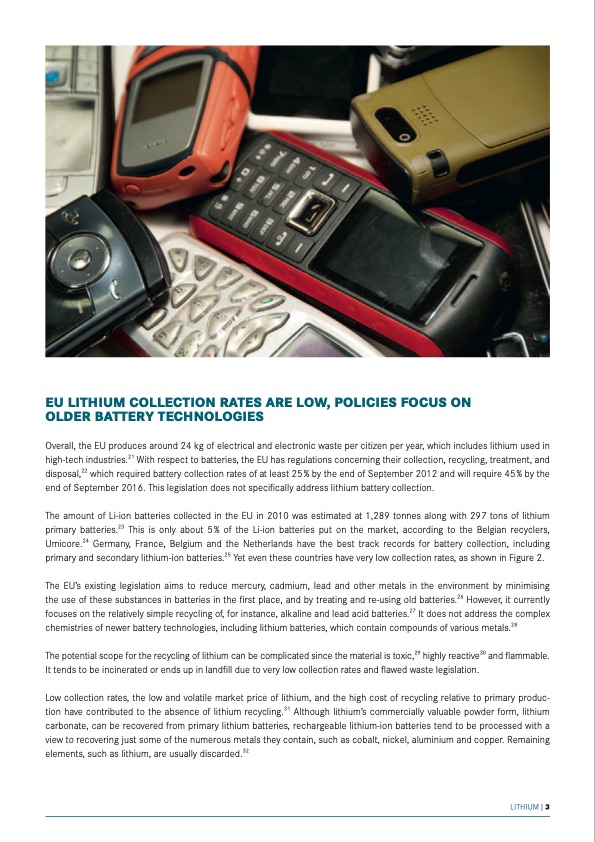
PDF Publication Title:
Text from PDF Page: 003
eu lithium ColleCtion rates are low, poliCies foCus on olDer battery teChnologies Overall, the Eu produces around 24 kg of electrical and electronic waste per citizen per year, which includes lithium used in high-tech industries.21 With respect to batteries, the Eu has regulations concerning their collection, recycling, treatment, and disposal,22 which required battery collection rates of at least 25 % by the end of September 2012 and will require 45 % by the end of September 2016. this legislation does not specifically address lithium battery collection. the amount of Li-ion batteries collected in the Eu in 2010 was estimated at 1,289 tonnes along with 297 tons of lithium primary batteries.23 this is only about 5% of the Li-ion batteries put on the market, according to the Belgian recyclers, umicore.24 Germany, France, Belgium and the Netherlands have the best track records for battery collection, including primary and secondary lithium-ion batteries.25 Yet even these countries have very low collection rates, as shown in Figure 2. the Eu’s existing legislation aims to reduce mercury, cadmium, lead and other metals in the environment by minimising the use of these substances in batteries in the first place, and by treating and re-using old batteries.26 however, it currently focuses on the relatively simple recycling of, for instance, alkaline and lead acid batteries.27 it does not address the complex chemistries of newer battery technologies, including lithium batteries, which contain compounds of various metals.28 the potential scope for the recycling of lithium can be complicated since the material is toxic,29 highly reactive30 and flammable. it tends to be incinerated or ends up in landfill due to very low collection rates and flawed waste legislation. Low collection rates, the low and volatile market price of lithium, and the high cost of recycling relative to primary produc- tion have contributed to the absence of lithium recycling.31 Although lithium’s commercially valuable powder form, lithium carbonate, can be recovered from primary lithium batteries, rechargeable lithium-ion batteries tend to be processed with a view to recovering just some of the numerous metals they contain, such as cobalt, nickel, aluminium and copper. Remaining elements, such as lithium, are usually discarded.32 Lithium | 3PDF Image | Lithium Li

PDF Search Title:
Lithium LiOriginal File Name Searched:
13_factsheet-lithium-gb.pdfDIY PDF Search: Google It | Yahoo | Bing
Product and Development Focus for Infinity Turbine
ORC Waste Heat Turbine and ORC System Build Plans: All turbine plans are $10,000 each. This allows you to build a system and then consider licensing for production after you have completed and tested a unit.Redox Flow Battery Technology: With the advent of the new USA tax credits for producing and selling batteries ($35/kW) we are focussing on a simple flow battery using shipping containers as the modular electrolyte storage units with tax credits up to $140,000 per system. Our main focus is on the salt battery. This battery can be used for both thermal and electrical storage applications. We call it the Cogeneration Battery or Cogen Battery. One project is converting salt (brine) based water conditioners to simultaneously produce power. In addition, there are many opportunities to extract Lithium from brine (salt lakes, groundwater, and producer water).Salt water or brine are huge sources for lithium. Most of the worlds lithium is acquired from a brine source. It's even in seawater in a low concentration. Brine is also a byproduct of huge powerplants, which can now use that as an electrolyte and a huge flow battery (which allows storage at the source).We welcome any business and equipment inquiries, as well as licensing our turbines for manufacturing.| CONTACT TEL: 608-238-6001 Email: greg@infinityturbine.com | RSS | AMP |